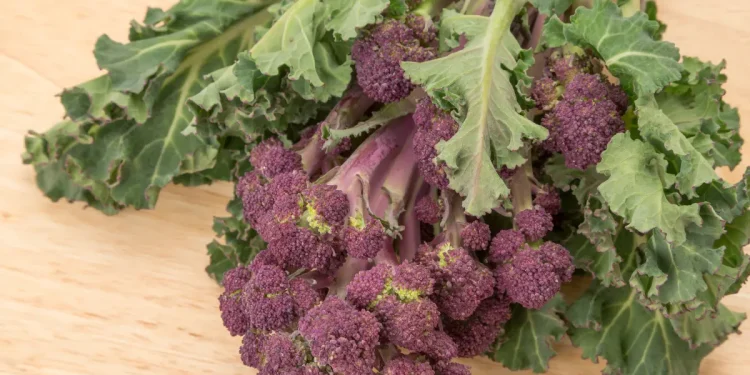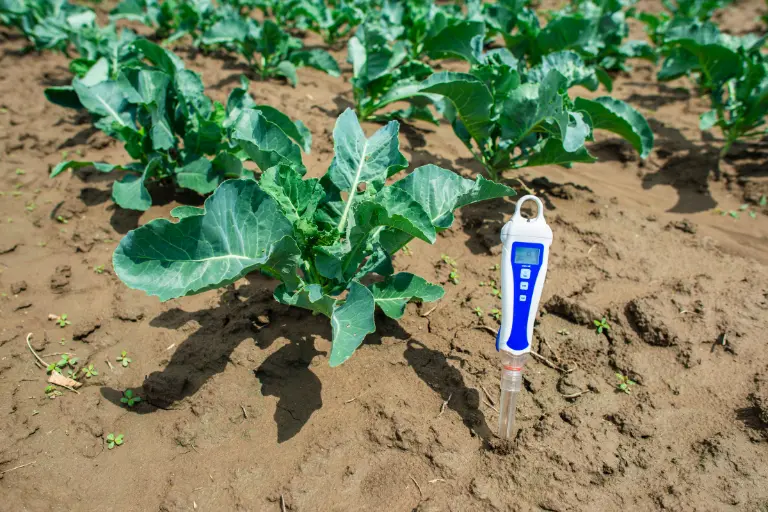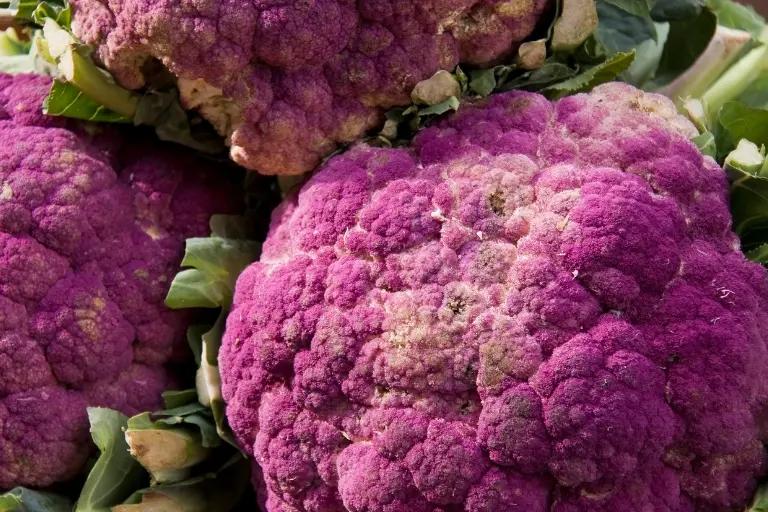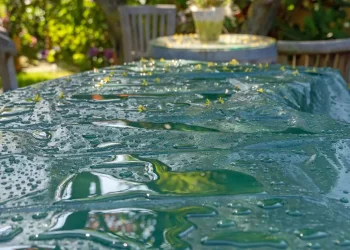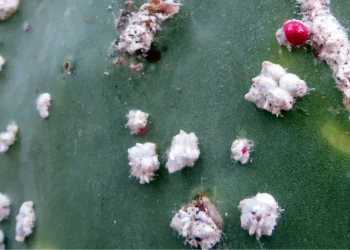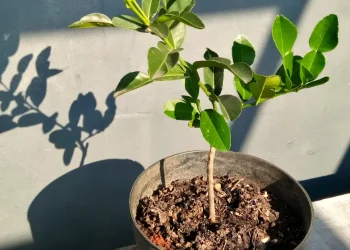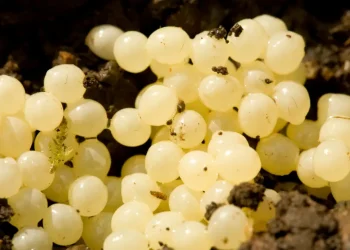When I came to my garden the other day, I was really surprised to see purple color on my broccoli leaves. The first thing that came to my mind at that moment was that I got invaded by some exotic pest that is leaving a purple trail behind. But the reason why was mine, and why probably also yours, broccoli leaves turning purple, is a lot simpler than that.
Broccoli plants have a remarkable ability to communicate through color changes. The key player here is a natural pigment called anthocyanin. Anthocyanins are blue, red, or purple pigments found in plants. If the pH level of the soil is too high or too low, or if there’s a deficiency in some of the key nutrients and minerals, it can trigger the release of anthocyanin, turning the leaves of broccoli purple.
In this article, I will show you all the things that can possibly be behind your broccoli leaves turning purple, and we’ll also look at how to fix it and return natural, vibrant green to the leaves.
What does Anthocyanin do in Broccoli Leaves
Anthocyanin is a vibrant pigment responsible for red, purple, and blue hues in various plants that can be also found in broccoli leaves. These pigments are part of a larger family called flavonoids, known for their antioxidant properties and potential health benefits.
Research suggests that including flavonoid-rich foods in your diet, may contribute to antioxidant protection in the body, reducing oxidative stress and potentially lowering the risk of chronic diseases like heart disease, certain cancerns and neurodegenerative disorders.
In broccoli leaves, anthocyanin exists in varying quantities depending on the type of broccoli. But the quantities are typically lower than in fruits like berries or grapes.
The release of anthocyanin in broccoli leaves is closely tied to the plant’s responses to its environment. When the broccoli plant experiences stressors such as changes in pH levels, temperature fluctuations, nutrient imbalances, or even insect attacks, it triggers a complex biochemical cascade.
It’s not as simple as one gland releasing a single substance, it is a whole complex of different substances being released in response to changes, each of them serving a different purpose. Anthocyanin primarily acts as a shield, helping to counteract potential damage caused by UV radiation, harsh weather conditions, and pests.
Are Purple Broccoli Leaves Safe to Eat?
As I highlighted in the previous section, anthocyanin that causes broccoli leaves to turn purple actually carries quite a few benefits. So not only it is perfectly safe to eat, but your health will also benefit from it, and it will add an interesting visual element to any dish.
However, even though these purple hues don’t signal any harmful changes in the broccoli’s edibility, the cause behind it can. The presence of anthocyanin in plant leaves in more than usual amounts can signal a response to stressors like pest attacks. If your broccoli leaves have been significantly affected by pests, it may not be a good idea to consume it, or at least in a raw form. In that case, ensure thorough cleaning and cooking, or toss them away.
What Causes Broccoli Leaves to Turn Purple
There are many different reasons why you might spot purple shades on your broccoli leaves. But usually, it has to do something with the health of the soil your broccoli is planted in – deficiencies of crucial minerals, a wrong pH of the soil… It may be harder to uncover the real culprit, but fortunately, there’s a whole range of universal fertilizers that focus on all these causes at once.
Apart from soil issues, the purple hue on the leaves can also be caused by sunlight or temperature. In this section, we’ll take a look at all possible causes and how to fix them.
Nutrient Deficiencies
One of the key factors that can cause broccoli leaves to turn purple is soil nutrient deficiency. Plants, like all living organisms, require a balanced diet of essential nutrients to thrive. In this case, the most important minerals are nitrogen, phosphorus, and potassium (NPK).
The second reason tight with nutrient deficiency is if the nutrient absorption in broccoli is impaired. This may come from other issues in the plant, such as root rot, various diseases, or pest infestation.
The symptoms don’t always stay with just a purple hue on the leaves and can vary depending on which nutrient is lacking. For instance, nitrogen deficiency can cause yellowing of older leaves and overall impaired growth, whereas calcium deficiency makes the tips of the leaves turn brown.
It’s not always easy to identify the one exact nutrient that is lacking in the soil or plant. First, the signs aren’t always straightforward, and second, even when you solve one nutrient deficiency, others may have been present all along, but signs will manifest later.
One solution is to use one of the available universal fertilizers that provide a balanced mix of essential nutrients. This is usually perfectly safe to use as a dangerous excess of nutrients is more or less rare.
For a more precise approach, you can get a soil testing kit at any gardening center. These are relatively cheap and will provide you with a general overview of the quality of your soil.
Wrong pH Level of the Soil
Most plants do well when the soil pH is slightly acidic, around 6.2 and 6.8 on the scale. The pH range goes from 0 to 14, with 0 being extremely acidic and 14 being extremely alkaline.
If you remember, there were two possible scenarios with nutrient deficiency – either the soil was poor in the essential nutrients, or the plant was unable to get them properly. This has also something to do with soil pH.
Soil pH limits the availability of certain nutrients. In slightly acidic soils, minerals like iron, manganese, and aluminum are easily accessible to plants, ready to be absorbed. But when we flip the scale and the pH shifts towards the alkaline side, these materials are essentially locked away, and others became more available, like calcium or magnesium.
When the pH of the soil is too much to one side (either too alkaline or too acidic), the plant can’t reach for the essential nutrients, which, however, are present in the soil. And as a response to that, the plant will release anthocyanin pigments, which will turn broccoli leaves purple.
In this case, testing the soil for the presence of all essential nutrients won’t show any issues. You must check the soil pH level. There are also dozens of different brands on the market with pH testing kits, which are even cheaper than kits for nutrient deficiencies.
If your soil is too alkaline, you can make it naturally more acidic with, for instance, coffee grounds or by adding lemon juice when watering.
If, on the other hand, your soil is too acidic, one natural way to make it more alkaline is by using wood ash.
Environmental Factors
Broccoli is a cool-season crop, and it’s quite sensitive to temperature changes. A sudden drop in temperature, especially during the night, can trigger a purple hue in the leaves. Once the weather normalizes, the anthocyanin levels will probably also, and the leaves will regain their usual green color.
To prevent this from happening, you can apply row covers or use horticultural fleece during cold nights.
But planting your broccoli in a very sunny place might not be the greatest idea either. Intense sunlight, particularly when coupled with cooler temperatures, can also release anthocyanin release.
Insect Attacks and Diseases
There are many insects and diseases that can descend upon your broccoli plants. Depending on the type, other symptoms will also appear.
The purple color on broccoli may be caused by blackleg disease. It is caused by bacteria in the soil, which causes overall wilting of the infected plants. But one of the earliest signs of this disease is purple to black spots all across the plant, especially on stems.
Any insect or fungi causes high stress on the plant, which can manifest as purple leaves. In both cases, it’s important to act fast. Although it’s not the most gentle solution, I’m always quick to reach for insecticide, as pests can easily attack your other plants, and fungi can easily spread.
You Chose Purple Broccoli Variety
And lastly, you may have chosen a purple variety of broccoli without really knowing it. At this point, when you visit any gardening store, there are hundreds of different seeds to choose from, and it’s tempting to grab the first packet you see.
Choosing purple broccoli is a great choice, it’s packed with anthocyanins and can create a great visual contrast on any plate. They don’t need any special care in comparison to ordinary green broccoli. But they usually don’t grow one large single head but multiple smaller sprouts.
If you are looking to try one of these, my favorites are Summer Purple or Red Admiral. But there are plenty of other interesting varieties.
How to Fix and Prevent Purple Leaves on Broccoli
Fixing and preventing purple leaves on broccoli sounds a lot easier than it is. You just have to provide your broccoli with the right growing conditions. Under ideal conditions, there won’t be anything triggering the release of anthocyanin and thus coloring the leaves purple.
Everything starts with the right soil. Make sure the soil contains all the essential nutrients in sufficient quantity and verify that the soil’s pH falls within the recommended values – ideally slightly acidic, between 6.2 and 6.8 pH.
Monitor your broccoli’s exposure to temperature fluctuations and intense sunlight. Broccoli thrives the best when the temperature of the air is around 68-70°F (20°C). Especially make sure to cover your plants during cold winter nights.
Water your broccoli regularly, and anything that can thwart the plans now is a disease or pest infestation.
Conclusion
The purple hue appearing on your broccoli’s leaves is caused by excess anthocyanin that is released when your plant is under stress. Anthocyanin is a pigment belonging to a larger family called flavonoids, which are actually tied to antioxidant properties and great benefits for your body. So eating purple-colored broccoli is perfectly safe.
While it’s great for you, your plant may be suffering. There can be a number of causes behind this, but the usual reason is nutrient deficiency or a wrong pH of the soil. But if you want purple broccoli that is thriving in every aspect, you can get one of the available purple broccoli varieties. My recommendation? Summer Purple or Red Admiral.

